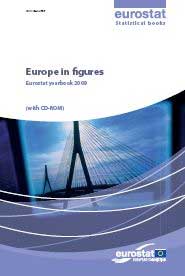 |
EUROPE IN FIGURES - EUROSTAT YEARBOOK 2009
(with CD-ROM)
European Communities, 2009, 567 pages
|
http://epp.eurostat.ec.europa.eu/cache/ITY_OFFPUB/KS-CD-09-001/EN/KS-CD-09-001-EN.PDF
В сборнике "Европа в цифрах 2009" представлен
комплексный отбор статистических данных по Европе. Ежегодник можно
рассматривать в качестве введения к европейской статистике. Большинство
данных охватывают период 1997-2007 годов для Европейского Союза,
некоторые показатели представлены для таких стран, как страны-кандидаты
в Европейский союз, члены Европейской ассоциации свободной торговли,
Япония или США. Около 500 статистических таблиц, графиков и карт,
ежегодника рассматривают следующие направления: экономика, население,
образование, здравоохранение, условия жизни и благосостояние, рынок
труда, промышленность и сфера услуг, сельское хозяйство, лесное
хозяйство и рыболовство, международная торговля, транспорт , окружающая
среда, энергетика, наука и техника, регионы Европы. В центре внимания
издания этого года глава, посвященная творческому потенциалу и новшествам
- тема европейского года 2009.
Contents
Introduction
The Eurostat yearbook
Eurostat - the Statistical Office of the European Communities
A practical guide to accessing European statistics
1. Science, technology, innovation and entrepreneurship: 2009,
the year of creativity and innovation
1.1 Education
1.2 Research and development
1.3 Science and technology personnel
1.4 Innovation
1.5 Patents
1.6 Business start-ups and entrepreneurship
1.7 Factors of business success
2. Economy
2.1 National accounts
2.2 Government finances
2.3 Exchange rates and interest rates
2.4 Wages and labour costs
2.5 Consumer prices and comparative price levels
2.6 Balance of payments - current account
2.7 Balance of payments - foreign direct investment
2.8 Development aid
3. Population
3.1 EU population compared with other regions of the world
3.2 EU-27 population
3.3 Components of population change
3.4 Families and births
3.5 Life expectancy
3.6 Migration and asylum
4. Education
4.1 School enrolment and levels of education
4.2 Foreign language learning
4.3 Tertiary education
4.4 Lifelong learning and vocational training
4.5 Educational expenditure
5. Health
5.1 Healthy life years
5.2 Health problems
5.3 Healthcare
5.4 Causes of death and infant mortality
5.5 Safety at work
6. Living conditions and welfare
6.1 Living conditions
6.2 Household consumption expenditure
6.3 Housing
6.4 Social protection
6.5 Good governance
7. Labour market
7.1 People in the labour market - employment
7.2 People in the labour market - unemployment
7.3 Job vacancies
7.4 Labour market policy interventions
8. Industry and services
8.1 Business structures
8.2 Industry and construction
8.3 Services
8.4 Tourism
9. Agriculture, forestry and fisheries
9.1 Agriculture - farm structure and land use
9.2 Agricultural output, price indices and income
9.3 Agricultural products
9.4 Agriculture and the environment
9.5 Forestry
9.6 Fisheries
10. External trade
10.1 Share in world trade
10.2 External trade in services
10.3 External trade in goods
11. Transport
11.1 Modal breakdown
11.2 Passenger transport
11.3 Freight transport
12. Environment
12.1 Climate change
12.2 Air pollution
12.3 Water
12.4 Waste
12.5 Environment and economy
12.6 Biodiversity
13. Energy
13.1 Energy production and imports
13.2 Electricity generation
13.3 Consumption of energy
13.4 Energy prices
14. Science and technology
14.1 Personnel
14.2 Expenditure
14.3 Patents
14.4 Information society
14.5 Telecommunications
15. Europe's regions
16. Linking statistics to European policies
Annexes
NUTS (classification of territorial units for statistics)
NACE Rev. 1.1 (classification of economic activities in the European
Community)
SITC Rev. 4 (standard international trade classification)
ISCED (international standard classification of education)
Statistical symbols, abbreviations and acronyms
Subject index
Selection of Eurostat publications
|

